If there is one long-established generalist Hi-Fi manufacturer that is seeking to occupy an important position in the digital music market - without having waited to merely jump on the bandwagon - that manufacturer is undoubtedly TEAC.
The Japanese manufacturer's catalogue also offers a wide range of independent DACs, most of which are non-portable, but there is also a portable model, the HAP-90SD, as well as mini Hi-Fi systems, such as the recent CR-H101.
For now, we have decided to present you with the NT-503 network drive benchmark. Recently put on the market by TEAC, this new device shares many similarities with the UD-503 DAC.
In fact, these almost identical looking models share an important electronic core, and one could almost say that the NT-503 network drive is a UD-503 DAC to which the manufacturer has added a network card, which wouldn't be far from the truth.
A trained eye will still notice some minor differences on the facades of the two devices, one of the two 6.35mm UD-503 headphone jacks, allowing several operating modes for the headphone amplifier, including a symmetrical mode, has disappeared to leave room for a USB A port, so that the NT-503 can read a USB storage device. You'll also notice the presence of a Bluetooth aptX receiver on the back of the device.
Capable of playing all kinds of existing digital audio files (either through a connection between a computer and the USB B port, a network server, or USB device - except for DXD 353 and 384 kHz in the latter two cases) and featuring both fixed-level and variable-level analogue audio outputs, the NT-503 network drive may be enough to constitute the heart of a Hi-Fi system on its own, by playing the role of a universal digital pre-amplifier. However it is important to note that it is exclusively digital as it doesn't have an analogue input (the UD-503 provides one in the area which is taken by the network card on the NT-503). You can't have everything, and if you could, what would be left of the UD-503?
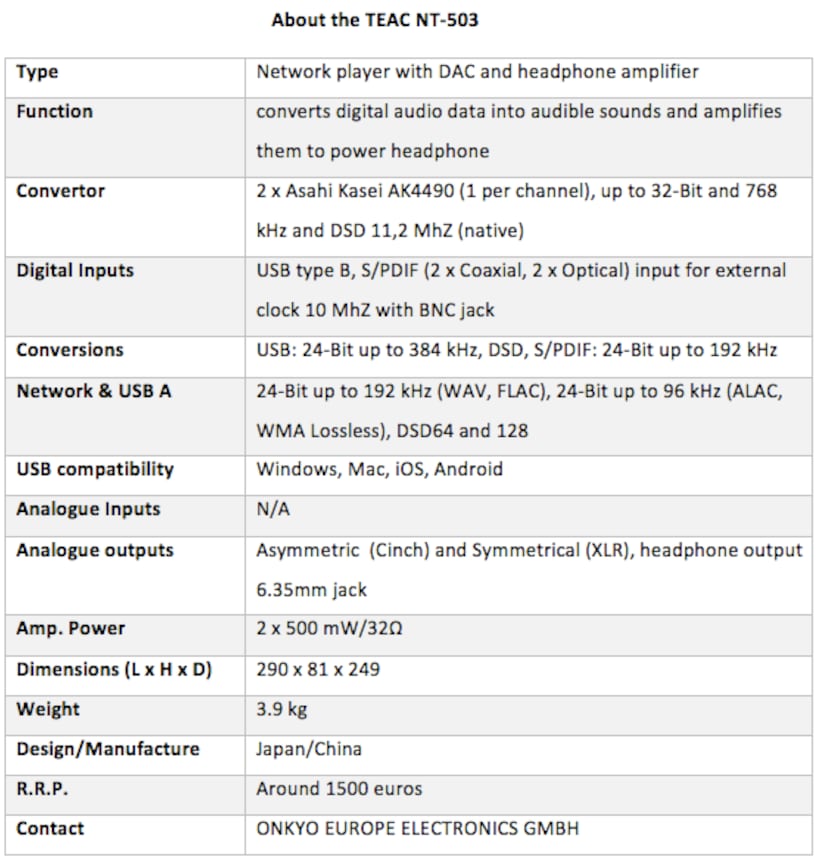
Presentation
The casing of the DAC TEAC NT-503, made entirely of aluminum and available in silver or black finishes, exudes seriousness and, to say the least, inspires confidence. Reminiscent of Tascam's successful professional-sector products, it has a fairly timeless look with its solid sides forming two handles, its buttons and its old-style toggle-switch.
Just to the right of this toggle switch is a 3.5mm jack entry port that can receive either an S/PDIF electrical signal through a male Cinch-jack adapter (included) or an S/PDIF optical signal via a 3.5mm Toslink-Jack adapter (not included). Above this outlet, a LED indicates that an external clock with an extremely stable synchronisation is connected.
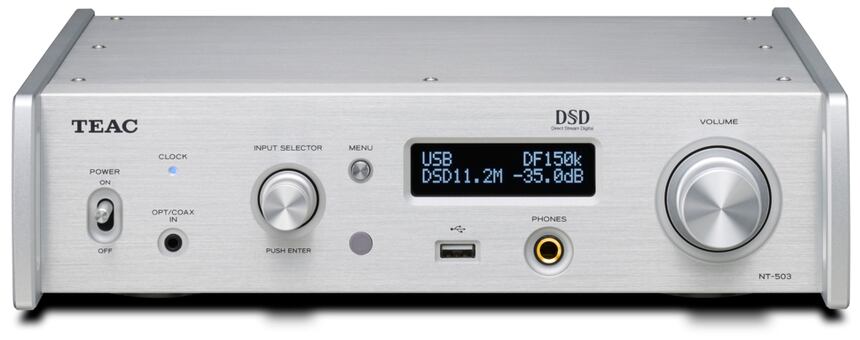
Next is the input selector, which also serves to navigate the menus (after pressing the menu button) and to select one of them, or one of their options thereafter. You can see the remote control receiver window vertically above the menu button.
The top line of the display shows the selected entry, whether or not the sample type is preserved (the NT-503 has a sampling rate converter, and PCM can even be converted into DSD), and if a filter is used, which filter it is. The bottom line of the display varies, depending on whether the volume is programmed to be fixed or variable, or whether any headphones are connected, and it will show either just the sample rate, or the sample rate and the volume. The volume switch will have no effect on the line output when the output level is selected to be fixed (possible options being 0dB or +6dB), but will always act on the level of the headphone output.
Under the display, there is a USB A port, allowing you to connect a USB storage device to read digital audio files, and a standard 6.35mm headphone jack.
Connectivity
On the right hand side and on the back you will find the electrical power input, three digital inputs, a USB B port (allowing the device to connect to a computer), and both coaxial and optical S/PDIF, as well as a BNC socket for a 10 MHz precision clock, allowing you to synchronise certain digital audio files. Next to this, you can see the plastic protective cover of the Bluetooth antenna which protrudes slightly from the casing, otherwise the Bluetooth module wouldn't be able to pick the radio-waves.

The RJ45 port, used to access the network via an Ethernet cable, is directly above the audio outputs, which are available in asymmetric mode from Cinch-jack ports, and in symmetrical mode from XLR ports, but not simultaneously. The hot and cold pins of the XLR jacks can be inverted via the menu.
Production
The interior was generously embellished for this TEAC NT-503 network drive, with part of the board being the same as in the DAC UD-503 model, such as the power supply, collecting its energy in two toroidal transformers, the USB card and the sound card.
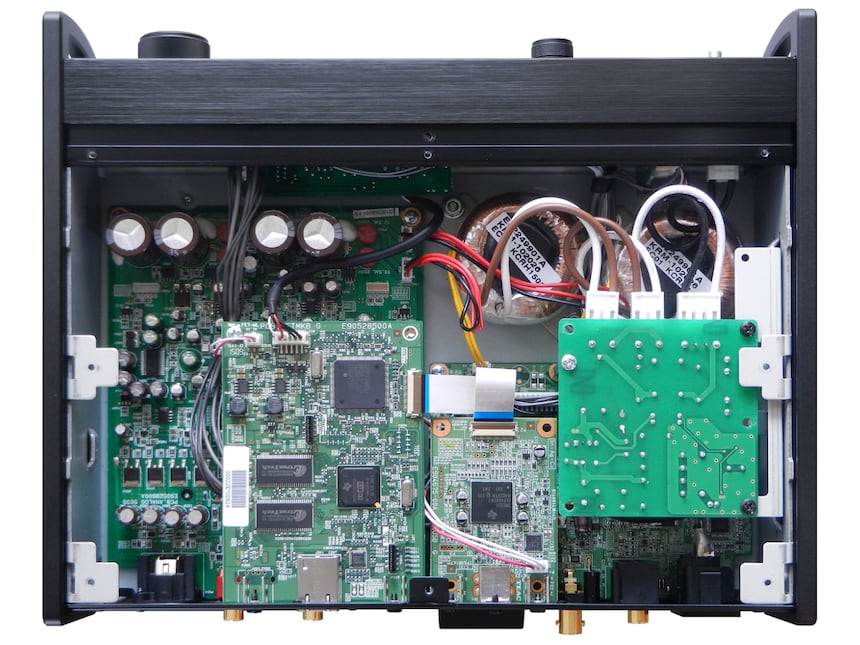
The USB interface occupies a small independent circuit and uses a DSP (digital signal processor) circuit, programmable Texas Instruments TMS320C6748B and integrating a USB 1.1 port, and a USB 2.0 port which is used to manage the audio stream from the USB connection.
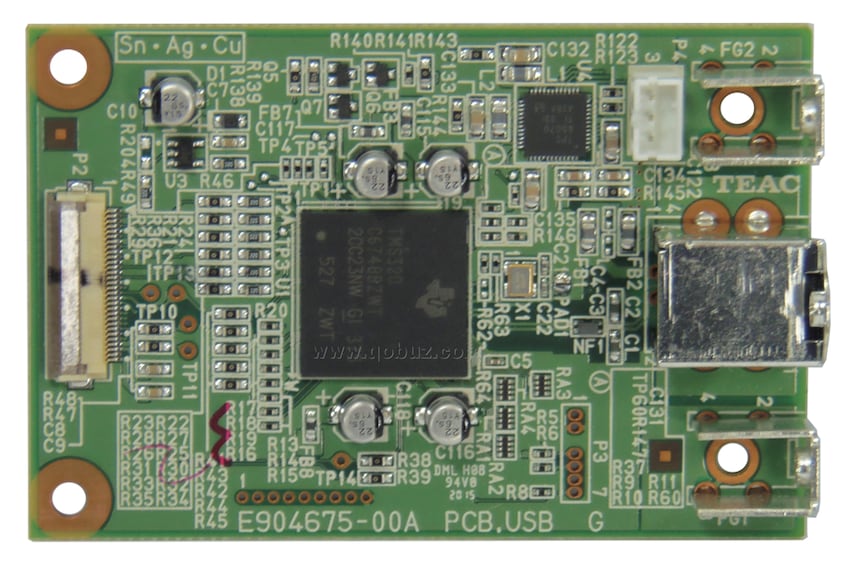
Another Texas Instruments chip, namely a TPS6507O, provides a 5V power to the board located below it (diagram below) and on which the S/PDIF interfaces (that are managed by a Burr-Brown PCM9211 circuit (24 bit 192 kHz)) are situated.
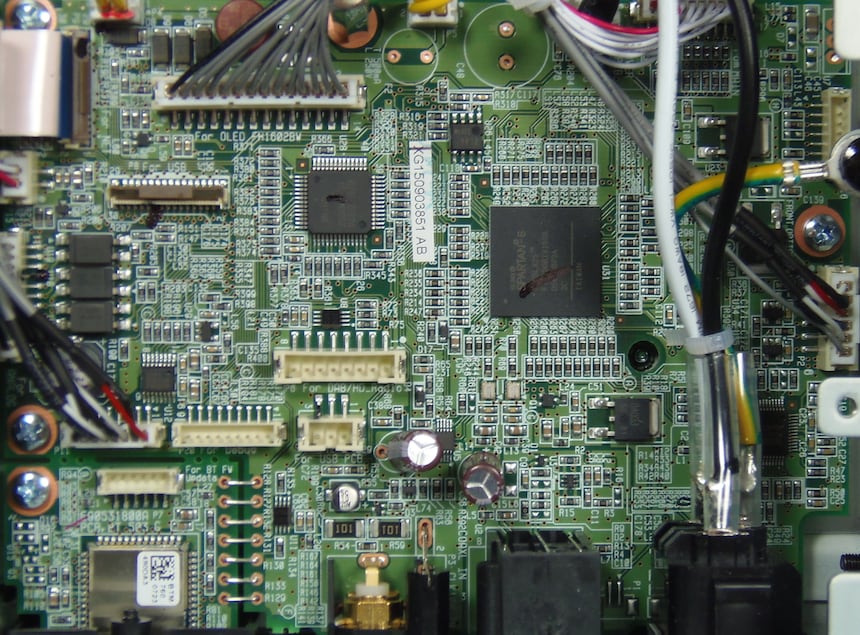
Also found on this board is a powerful programmable circuit (FPGA: field-programmable gate array) Xilinx Spartan XC6SLX25, move onto the digital processing developed by TEAC, especially sampling conversions including DSD, which can be seen on the visual below. To the right of this FPGA is the electronic management micro-controller.
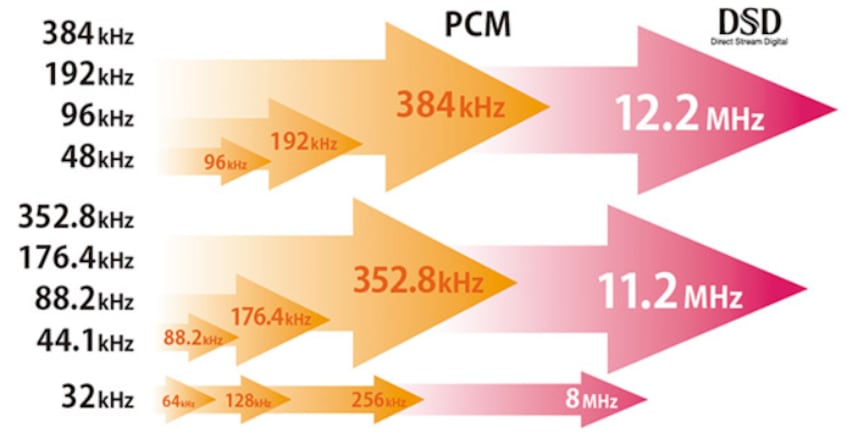
Also, at the bottom left of the display you can see the Bluetooth module with its protective cover, a Rayson BTM760 model that is aptX-compatible.
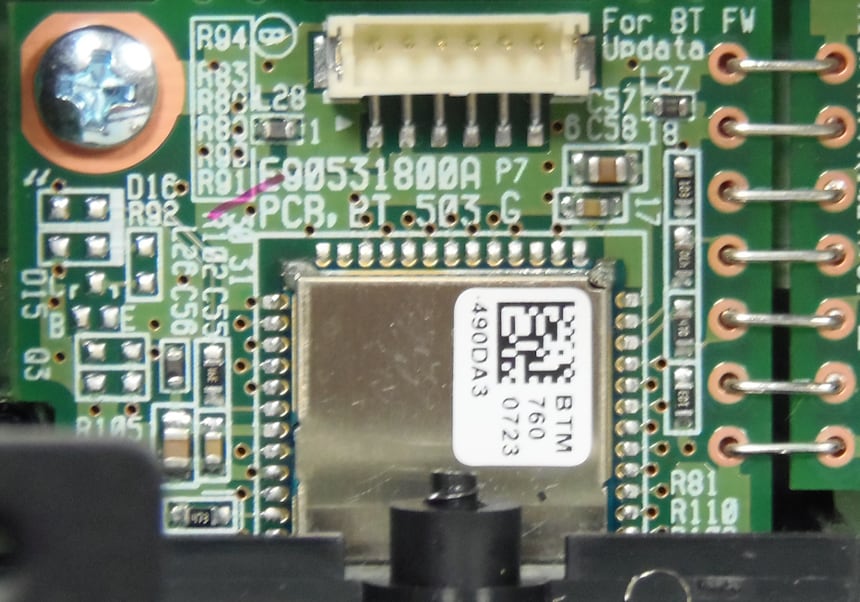
The network card is equipped with a Micrel KSZ8081 transceiver (located next to the RJ45 connector) for connection to the network, and then the signal processing is performed by a Texas Instruments D830K013DZ digital signal processor (DSP). Also on this side is a 32-bit Renasas V850 micro-controller.
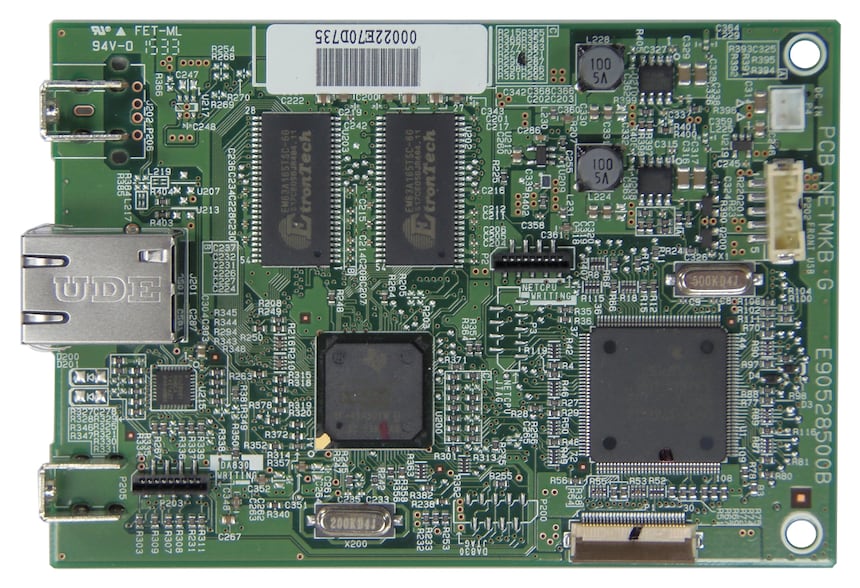
On the other side of this card you can see the memory that contains the code (instructions) and has a label marked NT-503.
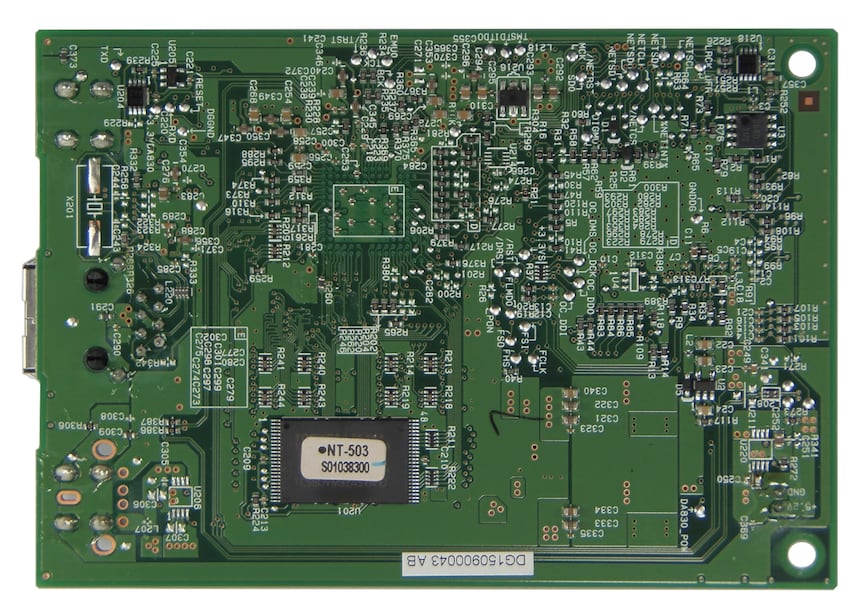
On the largest of the circuits occupying the device, which are visible below, there is a genuine dual mono configuration, starting with the power input, where two pairs of electrochemical 4700 µF/25V capacitors are located in order to filter the headphone amplifier input.
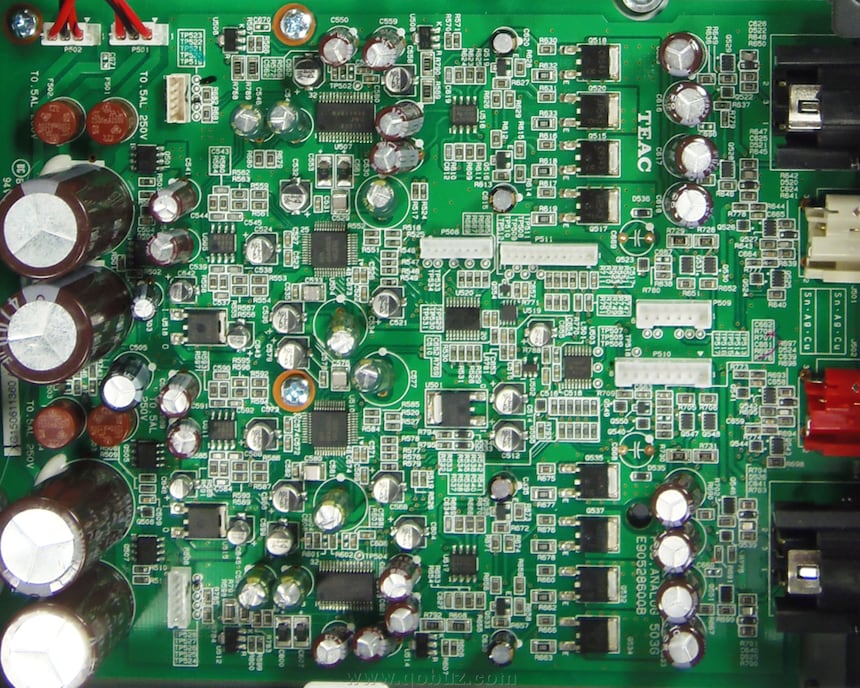
The analogue to digital conversion is provided on each channel with a Asahi Kasei AK4490 chip, from the Audio4pro series designed for professional equipment and high-end Hi-Fi. This chip is able to decode the PCM signals up to 32 bit at768 kHz, and DSD signals up to 11.2 MHz, natively or via a PCM conversion. It also includes various filters for PCM and DSD, which can be accessed via the NT-503 menu. The DACs' output filters are built around Muses8820 operational amplifiers, specially designed for audio by JRC (New Japan Radio Company).
Volume control on each channel is provided by a NJW1195 electronic potentiometer (also JRC) which can operate in differential mode with high accuracy.
Each channel has two headphone amplifiers, which also serve as the line outputs, one operating normally and the other reversing the signal phase in order to power the symmetrical output. Each amplifier is typically built with an operational amplifier (N5532 Texas Instruments) to provide the voltage gain and to deliver the power, a pair of 2SCR543 and 2SAR543 complementary transistors manufactured by Rohm, each of which can hold 1W of power without a cooler.
Use, listening
We can only congratulate TEAC for the user documentation provided (even if it took some searching to find the part about the network drive, which is in a separate booklet).
A lovely remote control is supplied with the NT-503 but you can only totally control the device via the TEAC AVR Remote app, available for iOS and Android, a rather flexible and intuitive application.
The different listenings we have made - either using a USB/Foobar2000 connection in KS mode as a software player or TEAC's HR Audio Player (much more user-friendly than Foobar and the with the ability to read the DSD without the tedious configuration like with Foobar) on the network, or reading from a USB key on the front panel - have all provided us with an immense pleasant listening experience, both through speakers and headphones. We have also used the preamplifier functionality of the NT-503 by connecting it to a NuForce STA-100 switching amplifier.
Thus, the beautiful Magnificat by Arnesen (test file DSD128 2L.no) is reproduced with an infinite tenderness, a great finesse on the vocals, and an aeration that creates a wide and ethereal reproduction. It is truly beautiful.
More rhythmic and also much more dynamic, the piece In the Hall of the Mountain King, from Grieg's 'Peer Gynt' , by Jeffrey Tate conducting the Berliner Philharmoniker, expresses itself in a manner which is somewhat less expansive than usual, that is not to say, however, that it has become conventional, far from it, but the NT-503's tendency to play a little softly is palpable.
The already naturally mind-blowing Isn't It A Pity from George Harrison's album All Things Must Pass is further accentuated by the TEAC NT-503, which would almost be an overdose, but it works rather well and we didn't aren't complaining!
There's no worrying about having a power supply for your headphones, the NT503 guarantees, and knowing that the volume can reach up to + 24dB and that the volume is already very comfortable at -30dB, there's really nothing to worry about! Again the sound quality is extremely enjoyable with the song Half Ladies from Christine and the Queens' album Chaleur Humaine , with a singer whose voice has a certain smoothness, but this absolutely does not prevent the bass accompaniment from making its presence felt.
As for the results with a Bluetooth aptX connection, they are consistent with those that provide this encryption whilst offering a sound quality level which is close to that obtained with uncompressed 16-bit at 44.1 kHz files.
In conclusion, with its NT-503 network drive, TEAC offers a real contender in the field of cloud music players, offering highly advanced DAC and network drive features and demonstrating exceptional digital audio file decoding capabilities. It also offers very good sound results along with preamp features, as well as an excellent and very powerful headphone amplifier. Highly recommended.
User Manual (En, Fr, Sp)
Network Usage Manual (En, Fr, Sp)
NT-503 on TEAC official website
To follow everything that happens at Qobuz, join us on Facebook!
If you are a manufacturer, importer, distributor or agent in the field of sound reproduction and would like to get in touch with us, please contact us at the following address: newstech@qobuz.com
If you are passionate about our Hi-Fi Guide section and want to get in touch with us, please do so only through the following address: rubriquehifi@qobuz.com
